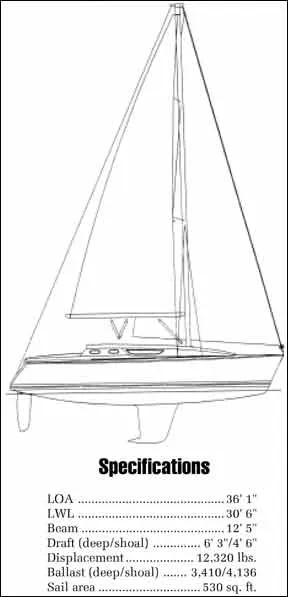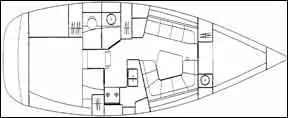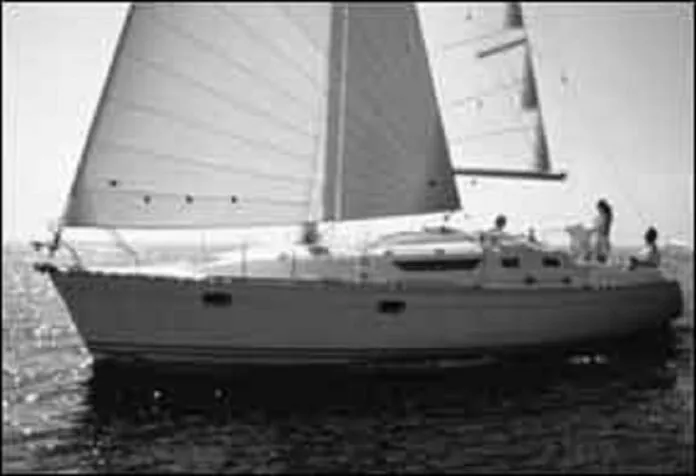Jeanneau was founded in 1956 by Frenchman Henri Jeanneau, who was primarily interested in building small outboard-powered boats. By the early 1970s, however, the company had done an about-face and was concentrating on the production of sailboats. It did not occupy a position of prominence in the marketplace, and was sold to the U.S. conglomerate Bangor Punta, which in the mid-1980s owned Cal, ODay and Ranger. That sale was followed by a second, to Chatellier Industry, and a third in 1995, when Beneteau, already one of the leading builders of sailboats, purchased Jeanneau. The combined companies became the largest producers of sailboats in the world, with each having total annual revenues in excess of $100 million.

Despite the ownership arrangement, the two companies operate with different management teams and distribution networks, and their production facilities are entirely separate. Jeanneau boats are built in France, Beneteau boats are built in France and South Carolina. However, logic dictates that their combined purchasing power should result in tremendous economies of scale, which should translate to higher quality boats, lower prices, or both.
Jeanneau produces monohulls ranging from 17′ to 52′ at a plant in Les Herbier, France; the companys Lagoon multihull line is built at TPI in Warren, Rhode Island.
Design
The Sun Odyssey 36.2 was designed by Jacques Fauroux and the Jeanneau design team. Introduced early in 1997, about 200 have been built to date. Its overall look is characteristic of the current European proclivity for dramatic round shapes-from the scoop transom, which looks like an orange cut in half, to the deck camber and interior moldings. Its the same with automobile styling these days: Square is out, round is in.
In profile, the bow has a short overhang and the sheerline is nearly flat. Its displacement/length ratio is 193, which is moderately low, meaning there is not much volume below the waterline and that there is a definite emphasis on speed. But because the 36.2 is intended to be an all-around family boat, the sail area to displacement ratio is a relatively conservative 15.9. The sail plan offers plenty of power to move her, but shouldnt require unusually early reefing to keep her on her lines. Comparatively flatbottomed boats such as the 36.2 like to be sailed fairly level and may exhibit undesirable handling tendencies when heeled excessively.
Though designed as a performance cruiser, the designers clearly intended the boat to be comfortable at anchor. The French Euro-style favors wide scoop transoms, which the marketing agencies highlight through ads showing bikini-clad girls sitting seductively on the steps, shower head in hand. The 36.2 fits this stereotype.
Because the beam is carried so far aft, the cockpit is spacious, as is the cabin underneath. Hence, the starboard lazarette is large enough to stow dock lines and fenders, but thats about it. The company says the port lazarette is large enough to stow a life raft, and a 6-foot adult can lower himself into it. If a life raft were stowed here, thats about all that would fit, and we would not recommend stowing a life raft in a compartment from which it might be difficult to extricate.
The designers have done an excellent job of camouflaging space for two propane tanks, which are located in a separate compartment aft of the lazarette and vented overboard-the proper method according to American Boat & Yacht Council (ABYC) standards.
Aft of the 50″ wheel and instruments, which are mounted on a pedestal, is the helmsmans seat, hinged so that it can be raised to provide access to the swim platform. Like many powerboats, the teak swim platform is equipped with a stainless steel ladder that rotates overboard, and a freshwater shower with hot and cold water. In marked contrast to many other quality details on the boat, the ladder unfortunately is held in place by a piece of shock cord. Shock cord does not last much more than a season in the sun; we would prefer a better means of securing the ladder.
Construction
There are some good things to be said about the hulls construction. Two sets of stiffeners are laminated to the hull; these stringers are laminated plywood about 4-1/2″ thick, run the length of the hull, and are covered with two layers of fiberglass mat. Five frames are fit perpendicularly to the centerline of the hull to produce a monocoque structure that should well support and stiffen the hull. We prefer this method to the type of fiberglass pan that is plopped into the empty hull and in which it is difficult to determine the quality of the hull bond.

Though the basics of the hull and deck lay-up are similar to that used at the Beneteau plant, the first layer of chopped strand mat in the hull of the 36.2 is wetted out with vinylester resins, shown to be superior in preventing blisters. Beneteau employs its own trademarked barrier material. The second layer is chopped strand mat, followed by three alternating layers of roving, all laid up by hand with polyester laminating resin. High load areas in the keel and mast step are reinforced with Kevlar and two layers of mat.
Bulkheads are tabbed their full perimeter to the hull and deck, which we very much like; on boats with fiberglass headliners, the bulkheads usually cannot be tabbed to the deck and so must be mechanically fastened. As the hull and deck work in a seaway, these can loosen. The 36.2 has a fabric headliner that is removable to access deck fittings.
The hull-deck joint is a flange that is bonded with Sikaflex, a polyurethane adhesive employed to prevent leaks, then fastened with stainless steel bolts, washers and nuts on about 4″ centers. An extruded aluminum toerail and PVC rubrail cover the joint.
Construction of the deck is similar to the hull, except that it is cored with end-grain balsa wood.
We give the French high marks for their ability to brighten spaces belowdecks by designing boats that are filled with light, even on cloudy days. Three amidships at eye level, and the third in the forward cabin. Additional light, and fresh air are introduced by one long window and two oval-shaped portlights located on each side of the dog house. There also are three Goiot deck hatches, including one over the V-berth. In our July 1, 1994 evaluation of hatches, we saw pros and cons to the Goiot product.
Our test boat was equipped with a pair of Goiot vents, though wed prefer Nicro solar vents because they move air day and night and replacement parts are more easily obtained.
Rigging And Deck Hardware
The mast is a sturdy-looking, aluminum double spreader rig with swept spreaders made by Z-Diffusion of France. Standing rigging is wire. The upper and aft lower shrouds terminate at a single chainplate; the load is transferred by an exposed tie rod that runs behind the settee down to a stringer. This is a strong design and the tie rod is not obtrusive. Forward lowers also are provided.
Halyards are routed inside the mast, which reduces chafe and noise. Similarly, reef lines and the outhaul are located inside the boom, which is also equipped with a soft vang. However, instrument wires inside the deck-stepped mast are led belowdecks about 6″ forward of the spar where they could be snagged by a persons foot. The backstay is split into a bridle for unobstructed access to the swimming platform. But this means it is not really feasible to adjust headstay tension when underway (by means of the turnbuckles). Though a minor consideration for family sailors, those interested in shaping the mainsail for improved performance will have to buy some Schaefer hardware involving triangle plates and blocks.
The main halyard, vang, mainsheet and genoa halyard are led aft through turning blocks to Spinlock sheet stoppers mounted on the coachroof. Mainsheet controls are located on a traveler atop the companionway. Jib sheets are led aft through French-made Amiot traveler cars. Deck hardware includes three self-tailing winches-two-speed Harken #44 sheet winches and a Harken #40 on the coachroof for halyards. This arrangement works well if the boat is fully crewed, but for singlehanders its a long trek from the wheel to the halyards.
Forward, there is a heavy stainless anchor bow roller and bow pulpit with built-in running lights. The smallish anchor locker is adequate for only a short length of chain and line-a disappointment. Profurl headsail furling is standard equipment and one of our most highly recommended brands. It is preferred over the Isofurl systems that Beneteau had to recall last year, and the Facnor system that replaced it. The furler drum is positioned about 6″ above the deck.
Standard deck hardware also includes four stanchions on each side, double lifelines, and a stern pulpit.
Belowdecks
Though the Jeanneau dealers with whom we talked said that the company places its emphasis on providing strong, fast hulls and less on stylish accommodations than Beneteau, we think they understated the quality of the interior. The boats will never be compared to a Hinckley, but they are well designed and well appointed, albeit less fashionable perhaps than the dark wood and chrome look of Philippe Starcks creations for Beneteau (either you like his work or you don’t).
The main cabin is reached via four teak steps and stainless steel handrails located on each side of the companionway. The steps are easily removed to get at the engine compartment, which is well insulated with double layers of soundproofing; we found engine noise to be virtually unnoticeable. Additional access to the engine is to starboard, where the fuel filter and dip stick for the 27-hp. Yanmar diesel are located.
Belowdecks is an L-shaped galley and dining area to starboard and a settee, nav station and head to port. The galley is equipped with a double stainless sink, hot and cold water on a mixer tap, and an Eno two-burner stove. Storage areas are located behind the stove, with cutouts in the teak facing for glasses and dishware, and below the sinks; theres also a separate compartment for garbage. The icebox capacity is 30 gallons and appears to be well-insulated. Countertops are light-colored laminates.
For the American market, Jeanneau has created an American interior that differs from those sold in Europe: The port settee converts to a full-size berth whereas European models have two chairs.
The U-shaped settee accommodates six adults. The only impediment is the shiny compression post for the mast that is located amidships near the table. There is stowage beneath each of the seat cushions, which are held in place with strips of hook and loop.
In addition to being spacious and comfortable, we found the cabin well-finished for a boat in this price range. Wood surfaces on cabinets, bulkheads and hull sides are smooth and nicely varnished; the sole is teak; the overhead liner reflects light to create an airy feeling; and 5″ cushions are fitted with durable fabrics that are removable for cleaning. The entire space is well lit by the combination of portlights, halogen ceiling lights and reading spotlights.
Fuel tanks, wiring for gauges, and batteries are in easily accessible compartments in the main cabin.
The skippers quarters are aft and starboard of the main cabin. Theres a modest hanging locker and a long shelf, with additional stowage beneath the 6’10” long x 6′ 4″ wide berth. The space is well lit by the hull window and opening cockpit portlight, two overhead lights and two reading lights.
The forward cabin is a tighter fit, with the double berth measuring only 4′ 11″ wide and 6′ 6″ long. There is standing headroom, however, of just more than 6′. Amenities in the forward cabin include two stowage lockers, one filled with shelving, the other a hanging locker, and a wash station with a stainless steel sink and faucet. The plastic water tank is located beneath this berth. Light and ventilation are provided by a hatch and two opening portlights in the hull.
A second adjustment for the American market is the 180 rotation of the nav station, which now faces aft. The console is large enough to house radios and navigation gear, and the electrical panel has 12 switches, two spares, and easy access to wiring. The downside is that seating is on the end of the settee, which has no backrest. The area also lacks shelving.
The head is located aft of the nav station and features a fiberglass washroom unit that includes a 12″ stainless wash basin with hot and cold water, Jabsco Par head, small storage area under the sink, and vanity/medicine cabinet that is enclosed by a Lexan door. The shower area, which also has a small storage compartment, is enclosed by an acrylic door.
Under Sail
With assistance from the Marine Service Center in Seattle, we arranged to test the 36.2 on a blustery day hours after yard-workers completed commissioning the first vessel delivered to the Northwest.
The boat motored at 6 knots, steered easily, and backed up in a straight line. Shes no lightweight, displacing slightly more than 6 tons, but seemed buoyant and responsive.
Despite our unfamiliarity with the boats systems, two of us had the main raised, the jib unfurled and trimmed, and the boat moving smartly within minutes after leaving the dock. Its not a complicated boat to sail. The 36.2 was responsive in the light winds we encountered during the early stages of our sail, though we discovered a need to induce weather helm by sailing with the traveler up.

Soon the wind built to 14-18 knots and the boat moved through the bumpy water with relative ease. We left the smallish 120% jib and mainsail fully hoisted, and discovered that she was quite controllable, though speed and comfort would be improved by shortening sail. We discovered that we could feather through puffs to keep from heeling and maintain speed. Hull speed for a boat with a 30.5′ waterline is about 6.5 knots, and we think shell do that.
The boom is short and positioned well above the cockpit so theres little fear of head-rattling during tacks. The 36.2 tacks and sails well off the breeze until the apparent wind angle reaches 140, at which point speed drops noticeably. We think the skipper who wants to sail quickly downwind will either opt for a spinnaker package, which will necessitate two additional winches, or a drifter, or become accustomed to sailing high jibe angles and frequent jibes, or going slow.
Conclusions
Compared to other boats in this size and price category, like Catalina and Hunter, we think this boat will appeal to casual daysailors and overnight cruisers. Though built sturdily enough to withstand an ocean passage, we would opt for a boat carrying more canvas for long-distance sailing.
Theres nothing particularly noteworthy about the deck layout, though the wide passageways allow for easy movement about the boat; the hardware is beefy enough for the loads they will bear; and the cockpit is comfortable.
Creature comforts belowdecks are well organized and nicely turned out, though we feel the forward berth will be uncomfortable for two full-sized adults. We like this interior better than many other Euromodels.
All in all, we think the 36.2 is a boat of modest aspirations that is roomy, easy to sail, and a reasonable value in todays astonishingly high-priced new boat market. At the Newport Boat Show, the dealers show special was $115,000 (usually $125,000, they said). For comparison, a Beneteau 36s7 was going for $112,200 and a Catalina 36 for $98,204.





































